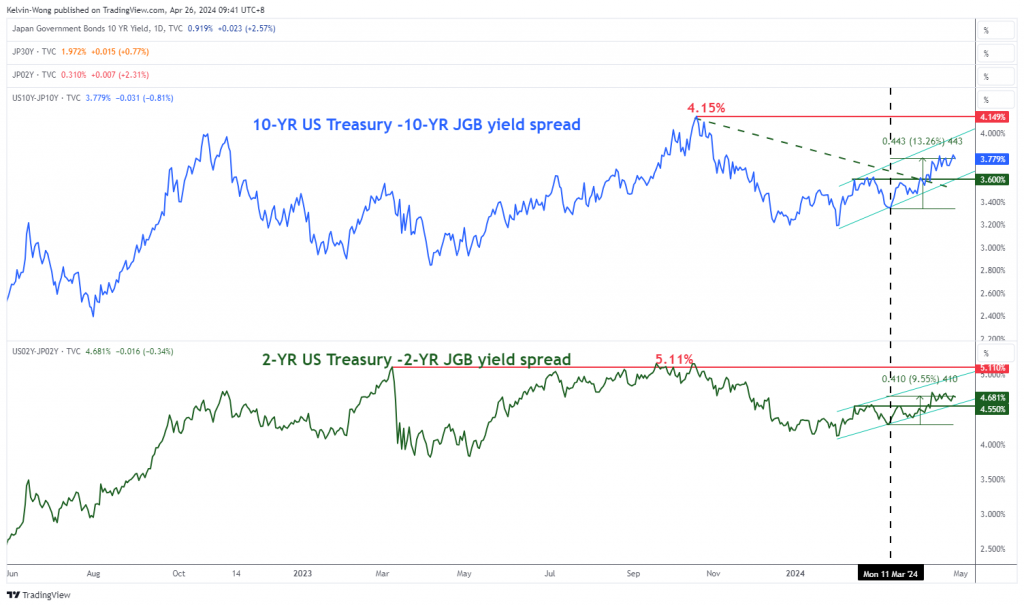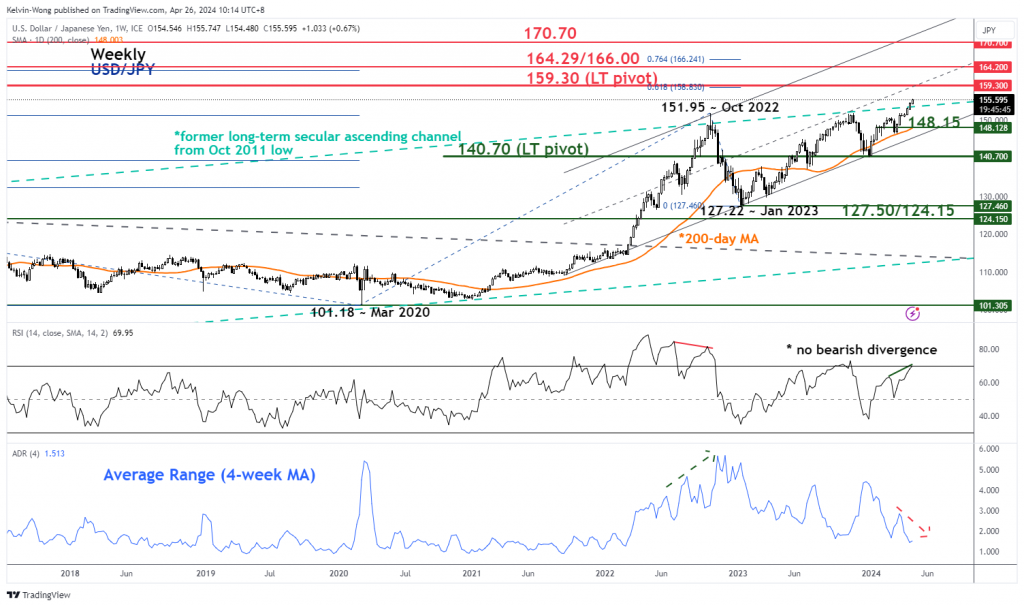- Tokyo’s core inflation rate in April was 1.8% year-on-year, the slowest pace of increase since September 2022 and below the Bank of Japan’s inflation target of 2%.
- The recent weaker-than-expected Tokyo CPI may delay the Bank of Japan’s next interest rate hike.
- The widening of the yield spread premium between US Treasuries and government bonds is likely to support the potential for further appreciation in USD/JPY.
- The current rise in USD/JPY since mid-March 2024 compares to the steeper rise seen from July 2022 to September 2022, which triggered actual currency intervention by the Treasury in October 2022. This is accompanied by a decline in volatility.
This is a follow-up analysis of a previous report. “USD/JPY Technical: Rise in yield spread between US Treasuries and government bonds exceeds Bank of Japan intervention risk” Published on April 11, 2024. Click here for a summary.
The USD/JPY price movement continued its relentless rise, breaking above the psychological level of 155.00 on Wednesday, April 24th, above the previous June 1990 swing high of 155.10. The US dollar rose +0.2% against the Japanese yen by the close of US trading yesterday, April 25, hitting a 52-week high of 155.75.
So far, USD/JPY has gained about +660 pips (+4.4%) from the historic Bank of Japan (BOJ) monetary policy decision on March 19, 2024 to end eight years of short-term negative interest rate policy. They are rising and raising interest rates. The overnight call rate was lowered to 0-0.1% for the first time in 17 years, and the 10-year Japanese government bond (JGB) yield curve control program was abolished.
In early Asian trading today, USD/JPY traded sideways in a narrow 10 pips range as market participants awaited the latest monetary policy decisions and economic outlook report from the Bank of Japan around 3pm Japan time. became.
The consensus is that there will be no change in the overnight call policy rate, and that Japan’s median core (excluding fresh food and energy) inflation forecast for fiscal 2024 will be slightly revised upward from 1.9% to 2% y/y. ing. And in 2025.
The timing of the next BOJ interest rate hike is unclear due to the slump in Tokyo’s core-core CPI
However, the timing of the Bank of Japan’s next interest rate hike could become a bit “complicated” as the latest Tokyo inflation data for April (released today) slowed from the previous month and was lower than expected. Tokyo’s core-core inflation rate (excluding fresh food and energy) was 1.8% year-on-year in April, a gradual decline from 2.9% year-on-year in March, and below the consensus of 2.7% year-on-year in September. This was the lowest pace of increase since then. 2022.
It was seen as a big surprise that Tokyo’s core-core inflation trend, often cited as a leading indicator of Japan’s national CPI, fell below the Bank of Japan’s 2% inflation target, with officials saying that over the past two months Japan has He expressed “high confidence” in the inflation target. The economy has managed to escape from the deflationary spiral environment that lasted for more than 10 years, and continues to maintain stable inflationary growth of around 2%.
Bank of Japan Governor Ueda’s reporters later today after the Japanese stock market close will therefore likely ask “questions” as to whether the soft developments in Tokyo’s CPI are the start of a new trend or just an outlier. The meeting will be extremely important. His guidance on how confident the BOJ is in its view of Japan’s inflation trends given this new set of data will reveal whether July is still “alive” until the BOJ’s next interest rate hike. there’s a possibility that.
Interventions to strengthen the yen may not be effective at this point.

Figure 1: Medium-term trend in U.S. Treasury/Treasury yield spreads as of April 26, 2024 (Source: TradingView, click to enlarge chart)
Over the past two weeks, there have been a number of verbal interventions from Japanese finance ministry officials to keep the dollar from rising as USD/JPY has exceeded the 151.95 level at which the Japanese authorities carried out actual currency intervention on October 21st. . In 2022, it spent nearly US$60 billion selling the US dollar against the yen.
At that point in late October 2022, the pace of rise in U.S. Treasury yields began to slow, and the yield premium over Treasury yields declined. Therefore, the effectiveness of Japan’s currency intervention was strengthened, pushing USD/JPY down -16% in three months to a low of 127.22 on January 16, 2023.
In the current situation, yields on Japanese government bonds have risen significantly since the last BOJ monetary policy meeting in March, with two-year government bond yields soaring to nearly 0.3%, the highest level in 34 years, at the time of writing. Despite this, it was 0% at the beginning of the year.
However, the long-anticipated Fed’s dovish pivot path that market participants accepted in early 2024 has evaporated as US inflation trends have become more robust and elevated, making US Treasury yields faster than Treasury yields. The pace rose.
The yield spread premium between 2-year and 10-year US Treasuries over Japanese government bonds has further widened by approximately 40 basis points (bps) since March 11, 2024, supporting the yen’s weakness against the US dollar (Figure 1).
Decrease in USD/JPY volatility over the past 5 weeks

Figure 2: Main trends in USD/JPY as of April 26, 2024 (Source: TradingView, click to enlarge chart)
Recent verbal interventions by Japanese Ministry of Finance officials have indicated that they will be monitoring volatility movements in the foreign exchange market, and that they are monitoring the movement of volatility in the foreign exchange market, and that there is a “desirable indication that actual intervention may occur if USD/JPY movements become sharp.” Emphasis is placed on monitoring for “no movement”.
Interestingly, the USD/JPY rally from the week of March 11, 2024 has been accompanied by relatively low volatility conditions as measured by the 4-week moving average of its weekly range (highest and lowest) .
In contrast, the four-week weekly range of USD/JPY rose significantly in the period from July 2022 to September 2022, before the actual currency intervention took place in October 2022 (Figure 2 ).
Therefore, given the reduced volatility associated with the current large USD/JPY rally, the Treasury may not intervene in the foreign exchange market.
The content is for general information purposes only. This is not investment advice or a solution for buying or selling securities. Opinions are those of the author. He is not necessarily OANDA Business Information & Services, Inc. or any of its affiliates, subsidiaries, officers or directors. If you would like to reproduce or redistribute content from MarketPulse, an award-winning foreign exchange, commodity, and global index analysis and news site service produced by OANDA Business Information & Services, Inc., please visit our RSS feed or Please contact us at the following address: info@marketpulse.com. For more information on global market trends, please visit https://www.marketpulse.com/. © 2023 OANDA Business Information & Services Inc.

